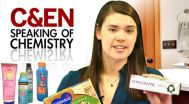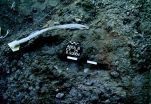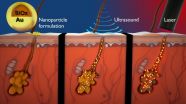Why 'hypoallergenic' isn't a thing (video)
2015-03-19
(Press-News.org) WASHINGTON, March 19, 2015 -- It's a simple claim made on thousands of personal care products for adults and kids: hypoallergenic. But what does that actually mean? Turns out, it can mean whatever manufacturers want it to mean, and that can leave you feeling itchy. Speaking of Chemistry is back this week with Sophia Cai explaining why "hypoallergenic" isn't really a thing. Check it out here: http://youtu.be/lXh8bnqMOZs.
Speaking of Chemistry is a production of Chemical & Engineering News, a weekly magazine of the American Chemical Society. The program features fascinating, weird and otherwise interesting chemistry topics. Subscribe to the series at http://bit.ly/CENOnline and follow us on Twitter @CENMag.
INFORMATION:
The American Chemical Society is a nonprofit organization chartered by the U.S. Congress. With more than 161,000 members, ACS is the world's largest scientific society and a global leader in providing access to chemistry-related research through its multiple databases, peer-reviewed journals and scientific conferences. Its main offices are in Washington, D.C., and Columbus, Ohio.
To automatically receive news releases from the American Chemical Society, contact newsroom@acs.org.
Follow us: Twitter Facebook
[Attachments] See images for this press release:

ELSE PRESS RELEASES FROM THIS DATE:
2015-03-19
The Canadian research community on high-temperature superconductivity continues to lead this exciting scientific field with groundbreaking results coming hot on the heels of big theoretical questions.
The latest breakthrough, which will be published March 20 in Science, answers a key question on the microscopic electronic structure of cuprate superconductors, the most celebrated material family in our quest for true room-temperature superconductivity.
This result is the product of a longstanding close collaboration between the University of British Columbia Quantum ...
2015-03-19
Some 2.5 million years ago, early humans survived on a paltry diet of plants. As the human brain expanded, however, it required more substantial nourishment - namely fat and meat - to sustain it. This drove prehistoric man, who lacked the requisite claws and sharp teeth of carnivores, to develop the skills and tools necessary to hunt animals and butcher fat and meat from large carcasses.
Among elephant remains some 500,000 years old at a Lower Paleolithic site in Revadim, Israel, Prof. Ran Barkai and his graduate students Natasha Solodenko and Andrea Zupanchich of Tel ...
2015-03-19
DENVER, March 23, 2015 -- Since HIV emerged in the '80s, drug "cocktails" transformed the deadly disease into a manageable one. But the virus is adept at developing resistance to drugs, and treatment regimens require tweaking that can be costly. Now scientists at the 249th National Meeting & Exposition of the American Chemical Society (ACS) are announcing new progress toward affordable drugs that could potentially thwart the virus's ability to resist them.
ACS, the world's largest scientific society, is holding the meeting here through Thursday. It features nearly 11,000 ...
2015-03-19
Washington, D.C.--To combat global climate change caused by greenhouse gases, alternative energy sources and other types of environmental recourse actions are needed. There are a variety of proposals that involve using vertical ocean pipes to move seawater to the surface from the depths in order to reap different potential climate benefits. A new study from a group of Carnegie scientists determines that these types of pipes could actually increase global warming quite drastically. It is published in Environmental Research Letters.
One proposed strategy--called Ocean ...
2015-03-19
What if there were a pill that made you more compassionate and more likely to give spare change to someone less fortunate? UC Berkeley scientists have taken a big step in that direction.
A new study by UC Berkeley and UC San Francisco researchers finds that giving a drug that changes the neurochemical balance in the prefrontal cortex of the brain causes a greater willingness to engage in prosocial behaviors, such as ensuring that resources are divided more equally.
The researchers also say that future research may lead to a better understanding of the interaction between ...
2015-03-19
URBANA, Ill. - Over the last several decades there have been substantial yield improvements in soybean. Because of new varieties and new agronomic practices, the yield potential in soybean is higher now than ever before. But a lack of updated information on the nutritional needs of soybean crops may be limiting the crop's potential.
Researchers from the University of Illinois Crop Physiology Laboratory led by Fred Below have recently provided an updated set of nutrition needs for soybean, identifying exactly which nutrients the plant needs, when those nutrients are accumulated ...
2015-03-19
Acne, a scourge of adolescence, may be about to meet its ultra high-tech match. By using a combination of ultrasound, gold-covered particles and lasers, researchers from UC Santa Barbara and the private medical device company Sebacia have developed a targeted therapy that could potentially lessen the frequency and intensity of breakouts, relieving acne sufferers the discomfort and stress of dealing with severe and recurring pimples.
"Through this unique collaboration, we have essentially established the foundation of a novel therapy," said Samir Mitragotri, professor ...
2015-03-19
Our eyes are drawn to several dimensions of an object--such as color, texture, and luminance--even when we need to focus on only one of them, researchers at New York University and the University of Pennsylvania have found. The study, which appears in the journal Current Biology, points to the ability of our visual system to integrate multiple components of an item while underscoring the difficulty we have in focusing on a particular aspect of it.
"Even when we want and need to focus on one dimension of things we come across every day, such as the texture of your cat's ...
2015-03-19
For in vitro fertilization and other assisted reproductive technologies, selecting the healthiest and best swimming sperm from a sample of semen can dramatically increase success. Microfluidics--micro-scale technologies that were originally developed to enable high-throughput gene sequencing and for Point-Of-Care diagnostics--are now being adapted to enhance sperm sorting. These new methods, reviewed by engineers in the journal Trends in Biotechnology, are generating promising results in applications such as single-sperm genomics, in-home male fertility testing, and wildlife ...
2015-03-19
A combination of human stem cell transplantation and antidiabetic drugs proved to be highly effective at improving body weight and glucose metabolism in a mouse model of type 2 diabetes. The findings, published March 19th by Stem Cell Reports, could set the stage for clinical trials to test the first stem cell-based approach for insulin replacement in patients with type 2 diabetes.
Type 2 diabetes, which accounts for 90%-95% of the now approaching 400 million cases of diabetes worldwide, is currently treated by oral medication, insulin injections, or both to control blood ...
LAST 30 PRESS RELEASES:
[Press-News.org] Why 'hypoallergenic' isn't a thing (video)



